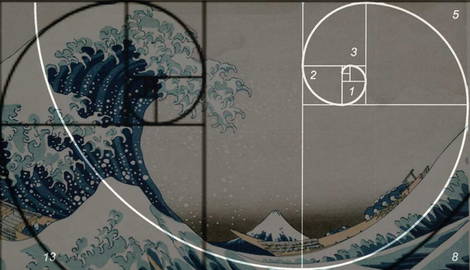
The golden ratio, also known as the divine proportion, is a mathematical ratio of 1:1.618, or Phi, with a decimal that stretches to infinity, closely linked to the Fibonacci sequence. Sometimes it is also referred to as the golden section, the golden mean, the golden number, the divine proportion, or the golden proportion. Many artists and designers throughout history have adopted this mathematical equation as a means of creating balance, order and symmetry.
The example below shows how the golden ratio looks – it appears as a large rectangle, divided into a series of squares. In order to find the exact proportions of the golden ratio, you can divide a rectangle into two, making sure the longer part divided by the smaller part is equal to the whole length divided by the long part. As you can see in the example below, the sequence of divisions can carry on ad infinitum in a curve.

A curved line running from one corner of the square to the next creates a mathematically ordered sequence, which occurs throughout patterns in nature, such as pine cones, flowers, and shells, as well as storms and galaxies. Little wonder then, that artists and designers through the centuries have seen this pattern as a means of replicating the wonder of nature in their art.

The mathematician Martin Ohm first coined the term ‘golden ratio’ in Die Reine Elementar-Mathematik (The Pure Elementary Mathematics), in 1815, but by then, many artists and designers had already made use of the compositional technique. Below, we look through some of the most famous artworks that demonstrate this neat compositional trick in action.
Leonardo Da Vinci, The Last Supper, 1495-8

One of the most famous examples of the golden ratio is Leonardo Da Vinci’s masterwork The Last Supper, 1495-8. During the Renaissance, artists called this compositional sequence “the divine proportion”, and even believed it had a spiritual, Biblical significance. In the image above, we can see how Da Vinci made use of the golden ratio formula throughout his painting, using it in multiple places to create a panoramic scene with an underlying mathematical order and harmony. Da Vinci demonstrated his understanding of the golden ratio in many of his other artworks, including The Annunciation, 1472-6, Vitruvian Man, 1490, and perhaps even in the Mona Lisa, 1503-9.
Michelangelo, The Creation of Adam, 1508-12

Much like Da Vinci, the Italian Renaissance master Michelangelo was deeply fascinated by mathematics, and how ordered, rational proportions could be applied in order to create harmonious designs. In his Sistine Chapel ceiling scene, The Creation of Adam, many believe Michelangelo made use of the golden ratio in order to convey the wondrous creation of human life as outlined in the Bible. We see how a structural pattern pulls our eye from the curve of Adam’s body around towards God, closing in on his eye at its apex.
Hokusai, The Great Wave off Kanagawa, 1831

Japanese artist Hokusai’s iconic ukiyo-e print The Great Wave off Kanagawa, made in 1831, is a more recent example of the golden ratio. While the wave may at first appear wild and spontaneous, closer examination reveals that Hokusai has in fact made a mathematically ordered design, in which a series of curved lines follow the golden ratio sequence. Thus Hokusai observes that even in its seemingly wildest moments, there is often pattern and structure underneath the forces of nature.
Piet Mondrian, Composition in Red, Yellow, Blue and Black, 1923

Dutch De Stijl artist Piet Mondrian is well-known for creating carefully arranged, geometric designs. He began his career painting trees, while gradually abstracting them in a bid to understand the underlying order or nature, so it is perhaps little surprise that the natural shapes of the golden ratio would pique his interest. This notion of order in nature also tied in with Mondrian’s fascination with Theosophy. In the painting Composition in Red, Yellow, Blue and Black, 1923, Mondrian plays with a series of decreasing squares that echo the pattern of the golden ratio.










